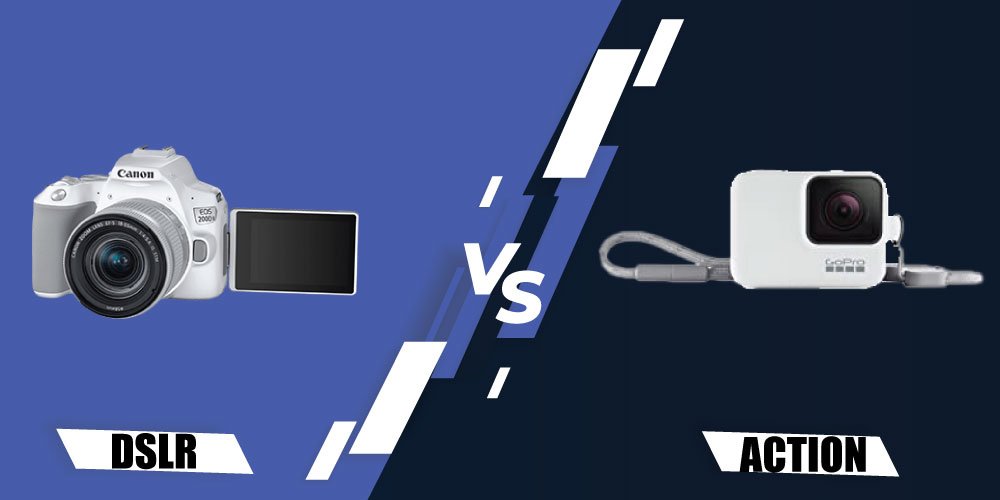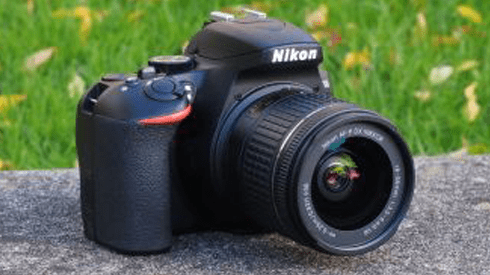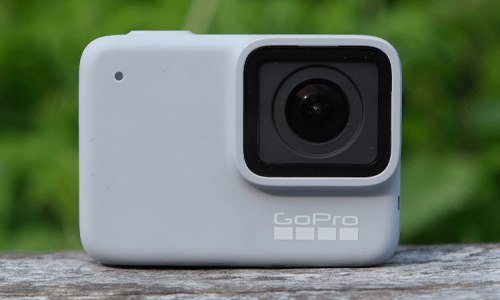In photography and videography, there has been an ongoing debate about which type of camera is better: DSLR cameras or Action Cameras. Both have unique advantages and disadvantages, so it can be difficult to decide which one is best for your needs.
This article will explore both options in detail by looking at their features, capabilities, and potential uses. We’ll also discuss why one may be a better choice than the other, depending on your photography or videography goals. By the end of this article, you will clearly understand what each type of camera offers and which one might fit your needs best.

Comparing Pros and Cons of DSLR and Action Cameras
DSLR Camera
Pros:
- High image quality as compared to other cameras.
- Offer more control over the settings and manual adjustment options.
- Possibility of interchangeable lenses for different shooting conditions.
- Ability to capture stunning details in a photograph with its large sensor size
- Great low-light performance due to larger sensors and fast lenses.
- Ability to attach different accessories such as flashes and filters.
- More reliable performance and faster autofocus capabilities than most point-and-shoot cameras.
- Allows for a greater degree of creativity when shooting due to the larger range of settings
Action Cameras
Cons:
- Bulky size and weight compared to action cameras
- The price is higher than most action camera models
- The learning curve for controlling all the features of the camera can be steep for inexperienced photographers
- Specialized lenses may need to be purchased in order to get high-quality shots
Action Cameras
Pros:
- They are smaller size and lighter weight, making them easier to take anywhere
- Ruggedized cases can provide an extra layer of protection against extreme weather conditions or shocks
- Easier to use for beginners without sacrificing quality
- Available at more affordable prices than DSLRs
Cons:
- Limited range of lenses available compared to DSLRs
- Video footage may not have the same quality as DSLR footage
- Shorter battery life than DSLRs
- Lower memory card capacity than DSLRs
Definition of DSLR Camera and Action Camera: What Are They?

What is a DSLR Camera?
Digital Single-Lens Reflex (DSLR) cameras are a type of digital camera that uses a mirror mechanism to direct light from the lens to the viewfinder. They have interchangeable lenses, allowing photographers and videographers to customize their camera setup with different optics. DSLRs also offer excellent image quality and manual control, making them widely popular for photography and videography.
What is an Action Camera?
While Action cameras are digital cameras designed for capturing action shots in extreme circumstances, they usually feature small form factors, ruggedized designs, waterproofing capabilities, and other features aimed at helping users capture images or videos from difficult angles or environments. Additionally, action cameras are more affordable than DSLR cameras, making them a popular choice for many on a budget.

Reasons for Comparing DSLR and Action Cameras
There are a few reasons why it’s important to compare DSLR and action cameras. For starters, both offer unique advantages and disadvantages, which can help make an informed decision. Additionally, price is often a major factor when choosing a camera, so you will want to weigh the cost of each option against its features.
Lastly, the type of photography or videography you plan on doing will influence which option is best for your needs – so it’s important to understand the differences between both cameras. By comparing DSLR and action cameras side by side, you can decide which one is right for you.
DSLR Vs. Action Cameras: Features That should Afraid
Image Quality and Sensor Size
In terms of image quality, DSLR cameras are superior to action cameras. This is due to their larger sensors which capture more light and provide higher levels of detail.
DSLRs typically have better low-light performance than action cameras, thanks to the larger sensor size and faster shutter speed. On the other hand, action cameras usually feature smaller sensors that can still produce decent image quality but won’t be as sharp or detailed.
Low Light Performance
Regarding low-light performance, DSLR cameras have a clear advantage over action cameras. As mentioned before, DSLRs have larger sensors which are better for capturing more light and providing higher levels of detail.
Additionally, DSLRs can also take advantage of faster shutter speeds, allowing them to capture sharper images in dimly lit environments. On the other hand, action cameras typically have smaller sensors and slower shutter speeds which can lead to less detailed images in low-light situations.
Video Quality
When comparing the video quality of DSLR and action cameras, there are a few key factors to consider. Firstly, DSLR cameras generally have much higher resolution than action cameras.
This means they can capture more detail in the footage they shoot, allowing you to produce high-quality videos with minimal effort. DSLR cameras can usually capture footage in a wider range of lighting conditions, meaning you won’t have to worry about dark or overly bright shots.
On the other hand, action cameras are typically smaller and lighter than DSLRs, making them ideal for capturing action shots from unique angles and perspectives. Additionally, many action cameras offer wide-angle lenses, allowing them to capture more of the scene than a DSLR would.
Furthermore, action cameras often have built-in image stabilization technology, which can help reduce camera shake and make your footage look smoother.
Autofocus Abilities
DSLR cameras typically have more advanced autofocus abilities than action cameras. DSLR cameras feature a variety of autofocus modes, such as single-shot AF (AFS), continuous-servo AF (AFC), and manual focus, which allows for capturing sharp images even when the subject is moving quickly. DSLR cameras also offer more control over autofocus points, allowing for precise and accurate focus on specific subjects.
In contrast, action cameras have limited autofocus capabilities. Most action cameras only offer a single-shot AF mode, which is unsuitable for capturing fast-moving subjects. Action cameras also have fewer autofocus points than DSLR cameras, making it difficult to focus accurately on a specific subject.
Lens Selection
In terms of lens selection, DSLR cameras offer a much wider range of lenses than action cameras. While both types of cameras have interchangeable lenses, DSLRs typically offer more options, such as telephoto and wide-angle lenses.
This makes it easier for photographers and videographers to get the exact type of shot they want. On the other hand, action cameras usually feature dedicated lenses which can limit creative options.
Battery Life and Memory Card Capacity
Action cameras generally have significantly shorter battery life than DSLR cameras, although newer action cameras are making strides to improve their battery performance. Most action cameras need to be recharged after a few hours of continuous use, whereas DSLRs can go for days between charges.
Regarding memory card capacity, action cameras typically have much less storage than DSLRs. For example, most action cameras have limited internal memory of between 8 GB and 32 GB, while some DSLRs can support memory cards up to 2 TB in size.
This means that a single memory card with a DSLR camera can store far more images or videos than the same amount of space available on an action camera.
Durability & Portability
When it comes to durability and portability, both DSLR cameras and action cameras have their advantages. DSLR cameras are generally more sturdy due to their larger size, making them better suited for outdoor activities like hiking or camping, where they may be exposed to bumps or knocks. On the other hand, action cameras are smaller and lighter, meaning they can be taken almost anywhere and fit into tight spaces.
In terms of portability, action cameras are the clear winner. They often come with straps or harnesses that make it easy to attach them to helmets, bikes, backpacks, and even drones. On the other hand, DSLR cameras need more protection when traveling, such as waterproof cases or padded bags.
When it comes to durability, DSLR cameras are the preferred choice. Their heavier construction makes them more resistant to dust, water, and shock than action cameras.
However, some action cameras come with ruggedized cases that provide extra protection for extended use in difficult environments. For example, some cases are designed to withstand extreme temperatures, water, and dust.
Cost & Accessibility
When it comes to cost and accessibility, DSLR cameras generally have higher price tags than action cameras, but they also offer more features and capabilities.
DSLRs can provide higher-quality images and videos when compared to action cameras. They also offer a more intuitive interface, allowing more experienced photographers to take advantage of all the features and settings.
Action cameras are more affordable and easier to use than DSLRs. They are designed with simplicity in mind, allowing even novice users to start taking photos right away.
Additionally, many action cameras come with apps that make it easy to connect with a smartphone or laptop, allowing for easy content sharing.
FAQs: Frequently Asked Questions
Is A DSLR better than an action camera?
It depends on the purpose and usage. DSLR cameras offer superior image quality, more control, and flexibility when it comes to shooting. DSLRs are more expensive and bulkier compared to action cameras. Action cameras are typically more durable, portable, and easier to use than DSLRs, making them the perfect choice for capturing action sports and outdoor activities.
Is action cameras banned in India?
No, action cameras are not banned in India. However, there may be restrictions on the type of activities or places they can use. It is important to check with local authorities before using any type of recording device in public spaces or areas considered sensitive or restricted.
DSLR or Action Camera? Which one is better for action shots?
Action cameras are better suited for capturing action shots such as sports and outdoor activities. They are more durable, portable, and easier to use than DSLRs, which makes them great for capturing fast-paced action shots.
Which Is Best For Travel & Vlogging: DSLR or Action Camera?
Both DSLR and action cameras have their advantages when it comes to travel and vlogging. Action cameras are generally more portable, making them great for capturing on-the-go shots while traveling. However, DSLRs offer superior image quality and more features if you want to create a high-quality video blog. Ultimately, it comes down to personal preference and budget.
Conclusion: DSLR Vs. Action Camera
When it comes to choosing between a DSLR camera and an action camera, the decision depends on your needs as a photographer. If you are looking for high-quality images with sophisticated settings, a DSLR is an ideal choice.
On the other hand, if you want something more portable and convenient for capturing videos in extreme conditions or remote destinations, then an action camera would be your best option.
Both of these cameras have their own advantages and disadvantages; therefore, it is important to consider your budget and level of expertise before making any purchase.
Ultimately, no matter which type of camera you choose, it should provide all the features that meet your specific requirements.
